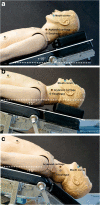The influence of different patient positions during rapid induction with severe regurgitation on the volume of aspirate and time to intubation: a prospective randomised manikin simulation study
- PMID: 30678655
- PMCID: PMC6346548
- DOI: 10.1186/s12871-019-0686-x
The influence of different patient positions during rapid induction with severe regurgitation on the volume of aspirate and time to intubation: a prospective randomised manikin simulation study
Abstract
Background: Aspiration is a main contributor to morbidity and mortality in anaesthesia. The ideal patient positioning for rapid sequence induction remains controversial. A head-down tilt and full cervical spine extension (Sellick) might prevent aspiration but at the same time compromise airway management. We aimed to determine the influence of three different positions during induction of general anaesthesia on the volume of aspirate and on participants' airway management.
Methods: Eighty-four anaesthetic trainees and consultants participated in a prospective randomised simulation study. Anaesthesia was induced in reverse Trendelenburg position (+ 15°) in a manikin capable of dynamic fluid regurgitation. Participants were randomised to change to Trendelenburg position (- 15°) a) as soon as regurgitation was noticed, b) as soon as 'patient' had been anaesthetised, and c) as soon as 'patient' had been anaesthetised and with full cervical spine extension (Sellick). Primary endpoints were the aspirated volume and the time to intubation. Secondary endpoints were ratings of the laryngoscopic view and the intubation situation (0-100 mm).
Results: Combining head-down tilt with Sellick position significantly reduced aspiration (p < 0.005). Median time to intubate was longer in Sellick position (15 s [8-30]) as compared with the head in sniffing position (10 s [8-12.5]; p < 0.05). Participants found laryngoscopy more difficult in Sellick position (39.3 ± 27.9 mm) as compared with the sniffing position (23.1 ± 22.1 mm; p < 0.05). Both head-down tilt intubation situations were considered equally difficult: 34.8 ± 24.6 mm (Sniffing) vs. 44.2 ± 23.1 mm (Sellick; p = n.s).
Conclusions: In a simulated setting, using a manikin-based simulator capable of fluid regurgitation, a - 15° head-down tilt with Sellick position reduced the amount of aspirated fluid but increased the difficulty in visualising the vocal cords and prolonged the time taken to intubate. Assessing the airway management in the identical position in healthy patients without risk of aspiration might be a promising next step to take.
Keywords: Airway management; Aspiration; Patient safety; Rapid sequence induction; Simulation.
Conflict of interest statement
Ethics approval and consent to participate
The ethics committee of the Friedrich-Alexander University Erlangen-Nuremberg approved the study (reference number 002_18 B, Chair Person Prof. Renke Maas, January 23rd 2018). Participants gave written informed consent prior to the study scenario.
Consent for publication
Not applicable.
Competing interests
The authors declare that they have no competing interests.
Publisher’s Note
Springer Nature remains neutral with regard to jurisdictional claims in published maps and institutional affiliations.
Figures




Similar articles
-
Combining head-neck position and head-down tilt to prevent pulmonary aspiration of gastric contents during induction of anaesthesia: a volunteer and manikin study.Eur J Anaesthesiol. 2012 Aug;29(8):380-5. doi: 10.1097/EJA.0b013e328354a51a. Eur J Anaesthesiol. 2012. PMID: 22634849
-
A simulated severe difficult airway does not alter the intubation performance with the SensaScope: a prospective randomised manikin study.Eur J Anaesthesiol. 2011 Jun;28(6):449-53. doi: 10.1097/EJA.0b013e3283460fc9. Eur J Anaesthesiol. 2011. PMID: 21544022 Clinical Trial.
-
C-MAC compared with direct laryngoscopy for intubation in patients with cervical spine immobilization: A manikin trial.Am J Emerg Med. 2017 Aug;35(8):1142-1146. doi: 10.1016/j.ajem.2017.03.030. Epub 2017 Mar 16. Am J Emerg Med. 2017. PMID: 28341185
-
Preoperative airway assessment - experience gained from a multicentre cluster randomised trial and the Danish Anaesthesia Database.Dan Med J. 2016 May;63(5):B5241. Dan Med J. 2016. PMID: 27127020 Review.
-
[Airway management in obstetrics].Ann Fr Anesth Reanim. 2011 Sep;30(9):651-64. doi: 10.1016/j.annfar.2011.03.024. Epub 2011 Jun 25. Ann Fr Anesth Reanim. 2011. PMID: 21705176 Review. French.
Cited by
-
Is older still good, or even better? Evaluation of possibility of using Miller laryngoscope for intubation in adults and comparison with the most widely used Macintosh laryngoscope. Protocol of a crossover randomized control trial.Heliyon. 2023 Oct 17;9(10):e21127. doi: 10.1016/j.heliyon.2023.e21127. eCollection 2023 Oct. Heliyon. 2023. PMID: 37916087 Free PMC article.
-
SAFE anaesthesia for patients at risk of pulmonary aspiration: A nationwide survey.Eur J Anaesthesiol Intensive Care. 2025 Mar 10;4(2):e0070. doi: 10.1097/EA9.0000000000000070. eCollection 2025 Apr. Eur J Anaesthesiol Intensive Care. 2025. PMID: 40206342 Free PMC article.
-
A way forward in pulmonary aspiration incidence reduction: ultrasound, mathematics, and worldwide data collection.Braz J Anesthesiol. 2023 May-Jun;73(3):301-304. doi: 10.1016/j.bjane.2021.05.004. Epub 2021 Jun 5. Braz J Anesthesiol. 2023. PMID: 34102227 Free PMC article. Review.
-
Effect of patient head position on the aspirated volume of regurgitated clear fluid. A fresh human cadaver study.Anaesthesiol Intensive Ther. 2020;52(5):395-399. doi: 10.5114/ait.2020.101434. Anaesthesiol Intensive Ther. 2020. PMID: 33327698 Free PMC article.
-
Assessment of the Possibility of Using the Laryngoscopes Macintosh, McCoy, Miller, Intubrite, VieScope and I-View for Intubation in Simulated Out-of-Hospital Conditions by People without Clinical Experience: A Randomized Crossover Manikin Study.Healthcare (Basel). 2023 Feb 23;11(5):661. doi: 10.3390/healthcare11050661. Healthcare (Basel). 2023. PMID: 36900666 Free PMC article.
References
-
- Wallace C, McGuire B. Rapid sequence induction: its place in modern anaesthesia. Continuing Education in Anaesthesia Critical Care & Pain. 2014;14(3):130–135. doi: 10.1093/bjaceaccp/mkt047. - DOI
-
- Benington S, Severn A. Preventing aspiration and regurgitation. Anaesthesia & Intensive Care Medicine. 2007;8(9):368–372. doi: 10.1016/j.mpaic.2007.07.011. - DOI
Publication types
MeSH terms
LinkOut - more resources
Full Text Sources
Medical
Miscellaneous

